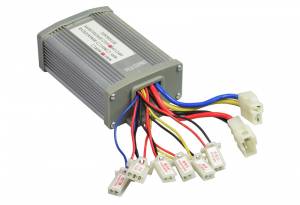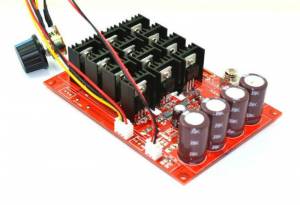Table of Contents
Motor Controllers
The toy you are originally starting from comes with some method to control the motor, often through a foot pedal switch that activates the motor directly or through a relay. The motor is either on or off. Besides optional “fast” and “slow” modes, there is no way to vary the speed of the motor on the original toy. Except for the switch or relay failing, this setup is generally pretty reliable for the tiny stock motors.
Assuming you are going to replace the motor with something more powerful, and (optionally) would like more granular control over the motor's speed, you will need to find a suitable motor controller to match your chosen motor. Depending on your setup, the motor controller can be a significant part of your budget, so it requires careful consideration.
There are generally two types of motor controllers, which must match your type of motor:
- Brushless
- Brushed
In addition, the speed controller will have specifications you must work within to prevent failure:
- Voltage - make sure the controller operates within you max/min voltage
- Current - make sure your controller can reliably control the amperage of your motor and batteries
- Throttle - some controllers accept 0-5v for throttle input; some require 0-5k ohm potentiometer input, some will accept either
Wikipedia has more information on the topic of electronic speed control.
Different speed controls have different features to be aware of:
- Variable speed
- Electronic braking (or even regenerative braking)
- Direction control (forward / reverse)
- Acceleration control
- Current control / amp limiter
Your options for obtaining your speed control are:
- New - lower power controllers can be had for cheap; high powered get very expensive very fast
- Used - Often a good choice for higher power controllers, if you can find a deal
- Build-your-own - Can be very inexpensive for lots of power, but obviously much more complicated.
New
The Internet has many new, very inexpensive “Chinese Controllers” floating around, in both brushed an brushless forms. They are generally designed for usage in scooters or e-bikes. There are also higher-powered controllers available for golf carts, but are generally much more expensive.
- in 2018, a 48V 1500/1800 watt brushless chinese controller was available on ebay for ~$27 price point.
- this family of controllers has:
- low-current e-stop wire pinned out that must be tied high for the controller to be enabled.
- reverse input
- top speed cut-off selector (typically does not change acceleration curve)
- accepts both(?) hall and resistive style throttles??? (need to confirm)
Sources:
Used
It is certainly possible to get a high quality / high power controller used for much less money than new. Some folks have gotten controllers at scrap metal prices, which is hard to beat. Good sources for controllers include electric fork lifts, pallet jacks, and golf carts.
Sources:
- Craigslist
- Your local scrap yard
Build-your-own
Building your own controller can be a rewarding process, but certainly involves more complexity.
There are some closed and open source motor controller projects out there to help get you inspired:
- The Paragon Controller (used in Fauxrarri): http://makercontrols.com/
- The Open Source Motor Controller (OSMC, they have a great discussion group): http://www.robotpower.com/osmc_info/
- Open ReVolt (They have 500a and 1000a designs): http://www.paulandsabrinasevstuff.com/WikiLinks.html
- Phantom Power Racing FPGA board: http://www.youtube.com/watch?v=HCmlAGlpR24

